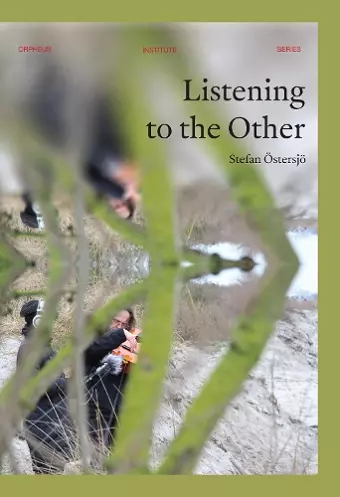Listening to the other
Format:Paperback
Publisher:Leuven University Press
Published:1st Jul '20
Currently unavailable, and unfortunately no date known when it will be back

New modes of listening and methods for contemporary sound art practices
Our contemporary, globalised society demands new forms of listening. But what are these new forms? In Listening to the Other, Stefan Östersjö challenges conventional understandings of the ways musicians listen. He develops a transmodal understanding of listening that is situated in the body—a body that is extended by its mediation through musical instruments and other technologies. Listening habits can turn these tools—and even the body itself—into resistant objects or musical Others. Supported by extensive multimedia documentation and drawing on examples from the author’s own artistic projects spanning electronics, intercultural collaboration, and ecological sound art, this volume enables musicians to learn how to approach musical Others through alternative modes of listening and allows readers to discover artistic methods for intercultural collaboration and ecological sound art practices.
This book is closely linked to a series of cutting-edge artistic works, including a triple concerto recorded with the Seattle Symphony and several video works with ecological sound art. It represents the analytical outcomes of artistic research projects carried out in Sweden, the UK, and Belgium between 2009 and 2015.
This publication is GPRC-labeled (Guaranteed Peer-Reviewed Content).
'Listening to the Other' is both innovative and rigorous as an account of how listening shapes the creative process within particular kinds of collaboration, and its methods will surely prove generative for those attempting similar analyses in a wide range of musical contexts.
Sam Mackay (2021): Listening, difference and the shackles of language, Sound Studies, https://doi.org/10.1080/20551940.2021.1907913
These compelling case studies are put into conversation with an impressive range of theoretical perspectives from musicology, postcolonial theory, sound studies, acoustic ecology, and the work of other artists (such as the Japanese artist Akio Suzuki, whom Östersjö interviews in the book’s audiovisual materials). Clearly, Listening to the Other advances studies of musical performance and distributed creativity. Yet it also contributes to theories of listening based in cognitive science and philosophy. Throughout, Östersjö’s thinking engages 4E cognitive science, according to which cognition is embodied, embedded, enactive, and extended. Here the book might be understood to describe instances of “cognition in the wild,” as in cognitive anthropology. Östersjö also responds to philosophers such as Jean-Luc Nancy and Emmanuel Levinas, and his case studies provide phenomenological insights about situated listening and (inter)subjectivity. Finally (and importantly), this book about musical practice has a practical aim, proposing an ecological, postcolonial ethics of listening. Insofar as listening involves relations with Others, it is already social and political, and Östersjö wishes to bring this aspect of listening to light, to put it to work. “Through musical practices and sound art,” he writes, “we must seek a thinking-through-listening that counters the dominant and anthropocentric powers of present-day politics. Listening to the Other then becomes an act of resistance” (p. 166). Jonathan De Souza, Musicae Scientiae, January 2021, https://doi.org/10.1177/1029864920983965
"I highly recommend 'Listening to the Other' to anyone who enjoys exploring new ways of thinking. Östersjö’s conversational writing style makes it feel like you’re sitting right alongside him on the riverbed, listening intently to his theories, as he adjusts the strings on the floating guitar, immersing us completely in his world."
Kris Rodriguez, Resonance (2020) 1 (3): 328–331, https://doi.org/10.1525/res.2020.1.3.328
ISBN: 9789462702295
Dimensions: 285mm x 195mm x 15mm
Weight: 670g
184 pages